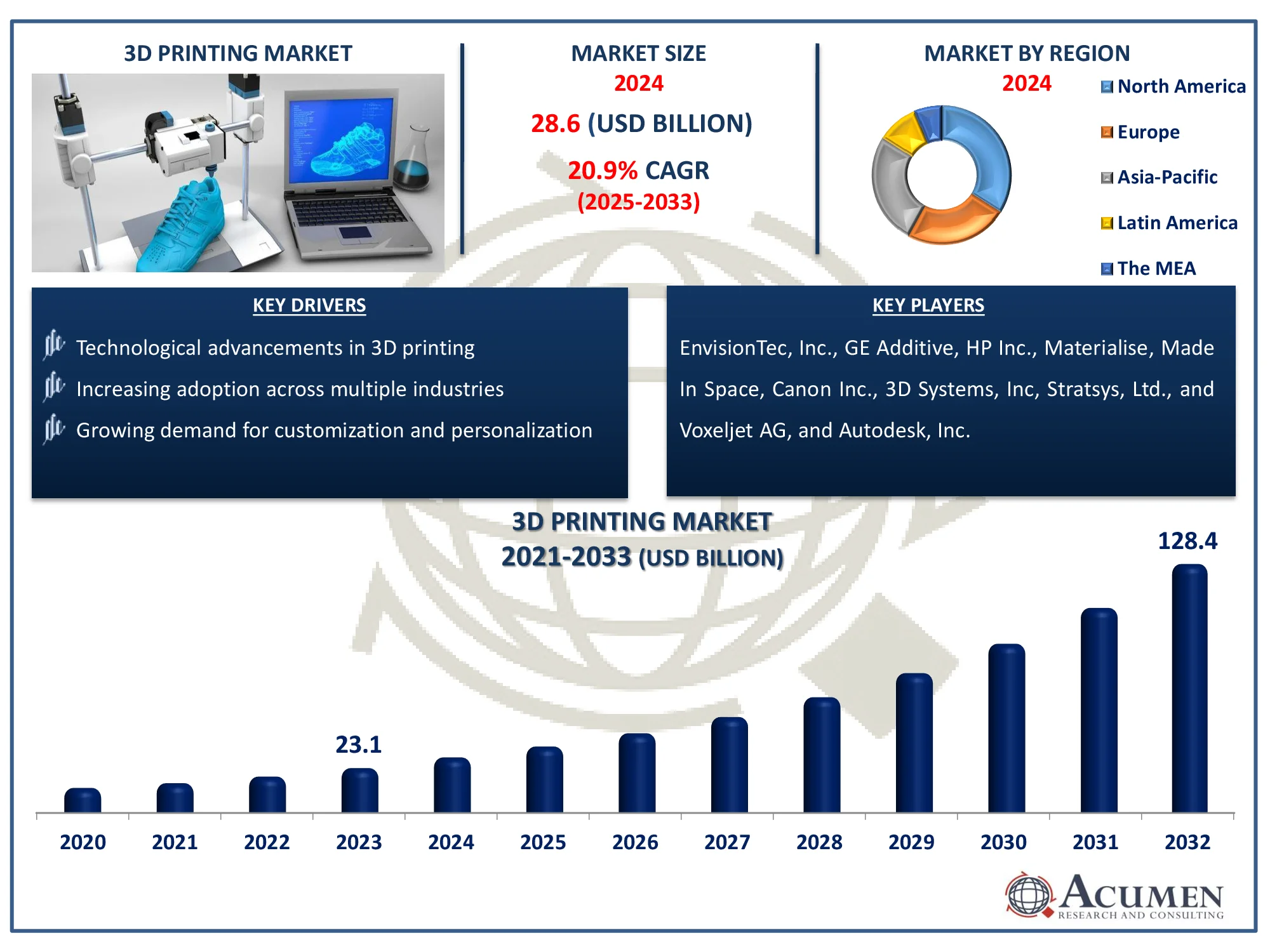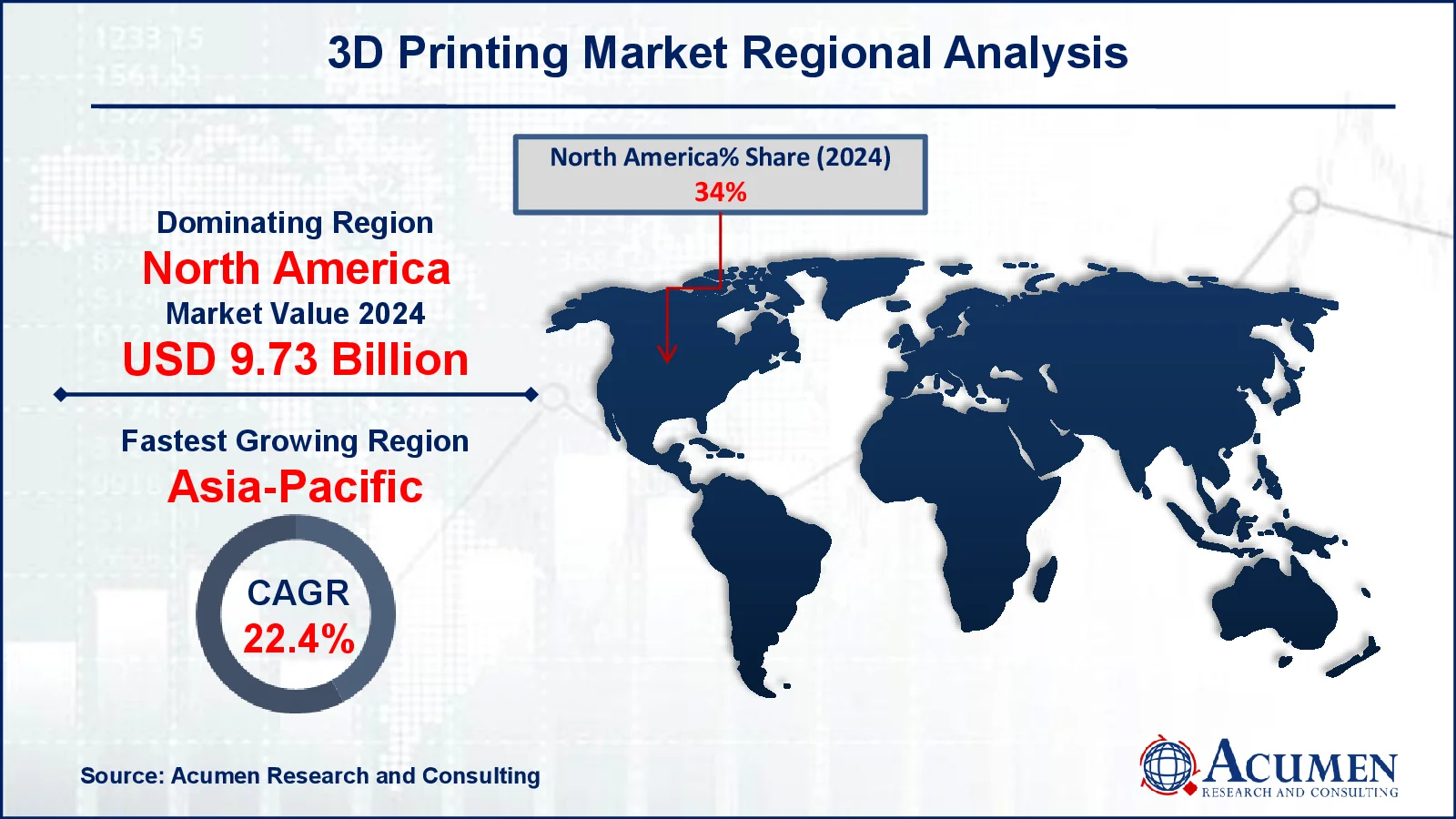June 2023
The Global 3D Printing Market Size accounted for USD 28.6 Billion in 2024 and is estimated to achieve a market size of USD 156.1 Billion by 2033 growing at a CAGR of 20.9% from 2025 to 2033.
The Global 3D Printing Market Size accounted for USD 28.6 Billion in 2024 and is estimated to achieve a market size of USD 156.1 Billion by 2033 growing at a CAGR of 20.9% from 2025 to 2033.

3D printing is the method of producing a three-dimensional solid object from a digital file or CAD model. This process, also known as desktop fabrication, additive printing, or additive manufacturing, involves layering tiny materials until the final structure is constructed. Several techniques are utilized in the development process, including powder bed fusion, material extrusion, vat photopolymerization, material jetting, binder jetting, directed energy deposition, and sheet lamination. Desktop and industrial 3D printers are used for printing.
In the healthcare sector, 3D printing is used in bioprinting, in which computer-guided pipettes deposit layers of living cells, known as bio-ink, to produce artificial tissues in medical laboratories. In the automotive industry, it allows for the creation of cost-effective plastic parts with reduced in-house production cycles, especially for complicated components. Meanwhile, engineers in the aerospace business use 3D printing for rapid prototyping, tooling, and efficient manufacturing of parts at lower costs.
|
Market |
3D Printing Market |
|
3D Printing Market Size 2024 |
USD 28.6 Billion |
|
3D Printing Market Forecast 2033 |
USD 156.1 Billion |
|
3D Printing Market CAGR During 2025 - 2033 |
20.9% |
|
3D Printing Market Analysis Period |
2021 - 2033 |
|
3D Printing Market Base Year |
2024 |
|
3D Printing Market Forecast Data |
2025 - 2033 |
|
Segments Covered |
By Component, By Technology, By Printer Type , By Material, By Vertical, By Application, and By Geography |
|
Regional Scope |
North America, Europe, Asia Pacific, Latin America, and Middle East & Africa |
|
Key Companies Profiled Aviation |
EnvisionTec, Inc., GE Additive, Autodesk Inc., Materialise, Made In Space, Canon Inc., 3D Systems, Inc, Stratsys, Ltd., Voxeljet AG, and HP Inc. |
|
Report Coverage |
Market Trends, Drivers, Restraints, Competitive Analysis, Player Profiling, Covid-19 Analysis, Regulation Analysis |
Manufacturers benefit from 3D printing for prototyping, product development, innovation, and decreased time-to-market, which are significant drivers of market expansion. For example, in June 2022, Israel-based Stratasys announced ambitions to expand its 3D printing company into India. The company serves well-known clients such as Ashok Leyland, Hero MotoCorp, AIIMS, Symbiosis, and IITs, leveraging its significant experience in design prototyping, manufacturing tools, and production parts. The ongoing commercialization of new technologies to enhance market share and develop sophisticated products is speeding up market expansion.
Furthermore, rising government investments and ongoing R&D in 3D printing technology globally are considerably increasing market value. According to the India Brand Equity Foundation (IBEF), the Gujarat government inked a Memorandum of Understanding (MoU) with the US Institute of 3D Technology and OEM 3D Systems to develop seven 3D printing Centres of Excellence at technical institutes and engineering colleges. Additionally, the Andhra Pradesh MedTech Zone collaborated with the University of Wollongong to establish a 3D bioprinting lab. The Department of Heavy Industries Centre of Excellence (COE) at IISc Bengaluru cooperated with Wipro to construct India's first industrial-grade 3D printer, while the Andhra Pradesh government and HP Inc. inked a MoU to establish a Centre for Excellence in 3D printing. The capacity to create customized products with lower manufacturing costs and process downtime is accelerating industry growth.
However, the substantial capital expenditure necessary for these technologies, as well as the increased cost of materials, presents barriers to industry expansion. Furthermore, the lack of consistent process controls remains a problem, which may impede growth during the predicted period. In contrast, developing applications in underdeveloped fields such as printed electronics and underwater 3D printing are likely to generate considerable growth prospects in the coming years.
 3D Printing Market Segmentation
3D Printing Market SegmentationThe worldwide market for 3D printing is split based on component, technology, printer type, material, vertical, application, and geography.
The hardware category, which comprises 3D printers, scanners, and other related components, is the primary driving force behind the 3D printing market. In 2024, hardware dominated the market, accounting for around 63%. The software section is the second-largest in the 3D printing industry, and it includes design software, simulation software, and other tools. In 2024, software accounted for around 28% of the market. Meanwhile, services, including 3D printing and maintenance, accounted for the remaining 9% of the market in 2024.
Accpording to 3D printing industry analysis, in 2024, stereolithography (SLA) technology will be dominant due to its high precision, smooth surface finish, and capacity to build complicated geometries with precise details. In April 2024, MatterHackers also purchased Source Graphics, a 3D printing product provider based in the United States. They forged a cooperation with Formlabs to progress their newly released projects utilizing stereolithography (SLA) and selective laser sintering (SLS) technology and offer them to manufacturing industry customers. The growing demand for high-quality, accurate 3D-printed components is driving the use of SLA technology.
The fused deposition modeling (FDM) segment had the fastest growing market share. Its position is sustained because of its cost-effectiveness in making long-lasting and sturdy parts for industries such as automotive, consumer products, and aerospace. Technological improvements have resulted in the creation of low-cost FDM solutions, propelling market expansion.
In terms of printer type, industrial 3D printers are often larger and more expensive than desktop 3D printers, making them suited for manufacturing and production environments. In 2024, the industrial 3D printer sector dominated the market, accounting for almost significant of share. Desktop 3D printers, on the other hand, are smaller and less expensive, and are mostly utilized by hobbyists and educators. Despite its strong rise in recent years, this category will account for notable growth of the market in 2024. Despite the increasing usage of desktop 3D printers, industrial 3D printers still lead in revenue generating.
In the realm of medical imaging, polymer materials will dominate the market share between 2025 and 2033. This is because polymer materials are extensively utilized in both desktop and industrial 3D printing, and they are less expensive than other materials. Polymer materials are employed in a variety of applications, including prototyping, product development, and low-volume manufacturing.
Metal materials are also a key part of the 3D printing business, particularly in industrial applications requiring high strength and endurance. Metal 3D printing is widely utilized in industries including aerospace, automotive, and healthcare, where metal components are essential for product performance and safety. Metal 3D printing is more expensive than polymer 3D printing, but it has some advantages, including great strength, corrosion resistance, and the ability to generate complicated designs.
According to the 3D printing market forecast, industrial 3D printing is the industry's leading income generator, thanks to its applications in aerospace, automotive, healthcare, and consumer goods. These printers are larger and more expensive than desktop ones, but they can produce high-quality precision parts on a huge scale.
Meanwhile, desktop 3D printing is a rapidly expanding area of the market. These smaller, less expensive printers are frequently used for hobbyist and educational purposes, as well as small-scale prototype and production.
According to 3D printing market forecast, prototyping has typically been the major application and remains a key area. The technique helps engineers and designers to create prototypes quickly and affordably, allowing for design testing and adjustments before committing to costly tooling or full-scale manufacturing.
Tooling is a significant use, notably in manufacturing. 3D printing enables the rapid and exact fabrication of molds, jigs, fixtures, and other tooling components, greatly lowering lead times and costs when compared to traditional manufacturing techniques.
With advances in 3D printing technology and the availability of new materials, the fabrication of functional parts is becoming a more significant market area. These high-performance components are frequently employed in industries such as aviation, automobiles, and healthcare.
North America
Europe
Asia-Pacific
Latin America
The Middle East & Africa
 3D Printing Market Regional Analysis
3D Printing Market Regional AnalysisIn terms of regional segments, North America had the biggest market share, owing to a series of new product launches, mergers, and acquisitions. For example, in March 2023, Neotech AMT collaborated with APES to increase the presence of 3D-printed electronics in the region. This relationship enabled both organizations to exchange resources and technologies, resulting in improved additive manufacturing capabilities. Furthermore, continuous technological improvements across numerous industries, such as automotive, healthcare, consumer electronics, and aerospace and defense, are adding to regional market expansion.
Meanwhile, the Asia Pacific market is likely to have significant expansion throughout the forecast period. This expansion is being driven by increased government efforts, R&D investment, and a strong industrial base. According to China's State Council Information Office, China will remain the world's largest manufacturing hub in 2023 for the 14th consecutive year, as announced by the Ministry of Industry and Information Technology (MIIT). According to Xin Guobin, vice minister of the MIIT, large manufacturing businesses with an annual main business turnover of at least 20 million yuan (about 2.8 million US dollars) saw a 5% year-on-year increase in value-added output in 2023. The overall value-added industrial output of major firms increased by 4.6% year on year, representing a 1 percentage point gain from 2022. These strong industrial bases are projected to support market expansion in the Asia Pacific region.
Some of the top 3D printing companies offered in our report includes EnvisionTec, Inc., GE Additive, Autodesk Inc., Materialise, Made In Space, Canon Inc., 3D Systems, Inc, Stratsys, Ltd., Voxeljet AG, and HP Inc.
Looking for discounts, bulk pricing, or custom solutions? Contact us today at sales@acumenresearchandconsulting.com
June 2023
May 2022
July 2021
September 2023